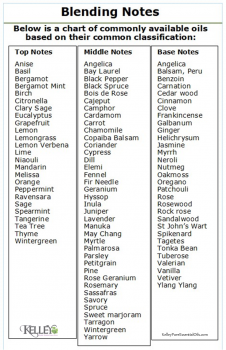Welcome Sign in
Product successfully added to your shopping cart
There are 0 items in your cart. There is 1 item in your cart.
Online only
Essential Oil Notes for Blending
Essential oil "notes" are what is used in essential oil blends. They bring the balance to the blend. Blending is the creative aspect of aromatherapy and it requires a balance of practice and intuition.
Essential oils are dynamic remedies because they are ‘synergistic’, meaning that they work together in harmony. Essential oils generally work better when mixed together with other essential oils.
New
More info
Blending Notes
Classical Blending Techniques
In the nineteenth century a Frenchman, Septimus Piesse, developed a method of classifying odors according to the notes in a musical scale. He transposed the idea of musical harmony into the realm of fragrances where the notes corresponding to each scent formed perfectly balanced chords or harmony when they were combined.
The practice of classifying essential oils and perfume ingredients into top notes, middle note and base notes still forms the basis of creating a well-balanced perfume and these principles may be applied to aromatherapy. A good perfume composition should harmoniously balance essential oils in these three categories.
A combination of orange and sandalwood, for example, can be very fresh and fruity at first, becoming more woody and balsamic later.
Top Notes – (5% to 20% of the blend)
Top notes are sharp, penetrating, highly volatile and the fastest acting. Top notes will hit you first in a blend. They do not last very long, but there are especially important in a blend as they give you the first impression of the blend. Top notes are usually uplifting and refreshing. Mental clarity.
Middle Notes – (50% to 80%)
Middle notes give body to blends; they smooth the sharp edges. They include oils such as geranium, lavender, rosemary and marjoram. They are warm, round and soft. They primarily affect functions of the body, e.g. digestion and the general metabolism of the body. (respiratory & nervous)
Base Notes – (5% to 20%)
Base notes, also known as fixatives, deepen the blend and draw it into the skin, giving it permanence. Typical base notes are sandalwood, patchouli, myrrh, frankincense, cedar wood and vetiver. When smelled form the bottle, base notes may appear faint, but when applied to the skin, they strongly react and release their power, which last for several hours. Base notes have sedative and relaxing effect. They are deep, intense and profound. Base notes slow down the evaporation of the more volatile essential oils, making their fragrance last longer.







